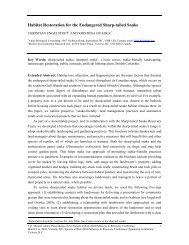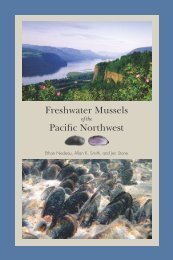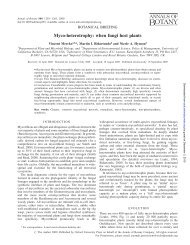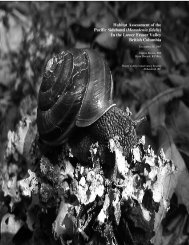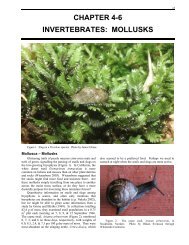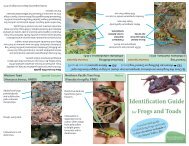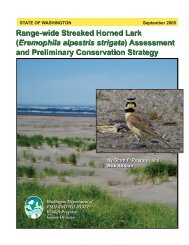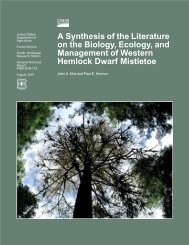Coastal Cutthroat Trout as Sentinels of Lower Mainland Watershed ...
Coastal Cutthroat Trout as Sentinels of Lower Mainland Watershed ...
Coastal Cutthroat Trout as Sentinels of Lower Mainland Watershed ...
Create successful ePaper yourself
Turn your PDF publications into a flip-book with our unique Google optimized e-Paper software.
13accounted for much <strong>of</strong> the variability <strong>of</strong> cutthroat abundance in small coho-cutthroatstreams, using 119 sites from Bella Coola and south (r 2 = 0.55; Rosenfeld et al. 2000).Anadromous <strong>Cutthroat</strong> Only ReachesAnadromous + Resident <strong>Cutthroat</strong> ReachesResident <strong>Cutthroat</strong> Only Reaches700<strong>Cutthroat</strong> <strong>Trout</strong> Biom<strong>as</strong>s g/100 sq m60050040030020010000 1 2 3 4 5 6 7 8Average Summer Wetted Width m9Figure 1. Juvenile cutthroat trout standing crops (total cutthroat biom<strong>as</strong>s per 100 m 2 ) inRegion 2 stream reaches versus wetted summer stream width (adapted from Deleeuw andStuart 1982: widths averaged from 1-2, 2-3, 3-5, 5-8 and 8+ m).Biom<strong>as</strong>s data for rearing co<strong>as</strong>tal cutthroat trout were also plotted by DeLeeuw and Stuart(1982) against average percent stream gradient. This clearly showed that streams <strong>of</strong> zerogradient supported zero rearing cutthroat, and streams near 0 to 0.5 % gradient supportedfew cutthroat. Typically, zero gradient reaches are sloughs or ditches, particularly withinthe lower Fr<strong>as</strong>er Valley. In striking contr<strong>as</strong>t, higher gradients from 0.5 % to >7 %supported high biom<strong>as</strong>ses per unit area (Figure 2). Of note, resident trout reachessupporting higher biom<strong>as</strong>ses per unit area were within the 4-8 m range <strong>of</strong> summer wettedwidths with moderate gradients <strong>of</strong> 2 %, the latter likely <strong>as</strong>sociated with boulderysubstrates and lower competition with sympatric juvenile coho salmon.As for the lentic waters <strong>of</strong> sloughs, ponds and lakes, cutthroat use is related to postglacialaccess, and to availability <strong>of</strong> nursery streams <strong>as</strong> well <strong>as</strong> the quality (cover) andproductivity (food availability) <strong>of</strong> the main water body. Further, some sloughs andditches are frequently only migratory corridors. Velocities can be low, and summer t<strong>of</strong>all conditions (particularly water temperature and/or dissolved oxygen) can be unsuitablein summer (unless groundwater-fed). Conditions may improve in fall to spring (Slaneyand Northcote 2003). For example, although velocities and depths are suitable in somesections <strong>of</strong> Mountain Slough and lower McCallum Ditch near Ag<strong>as</strong>siz, they are



